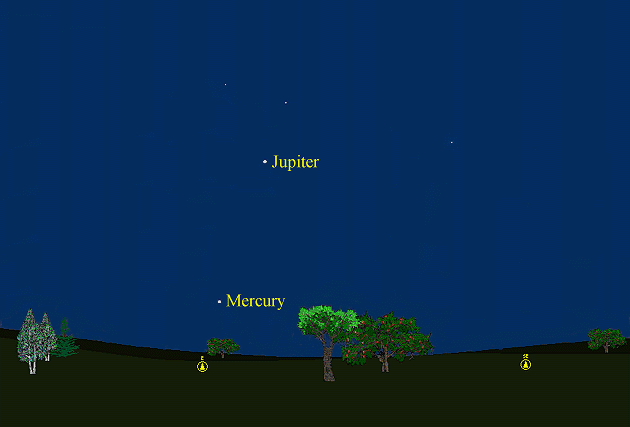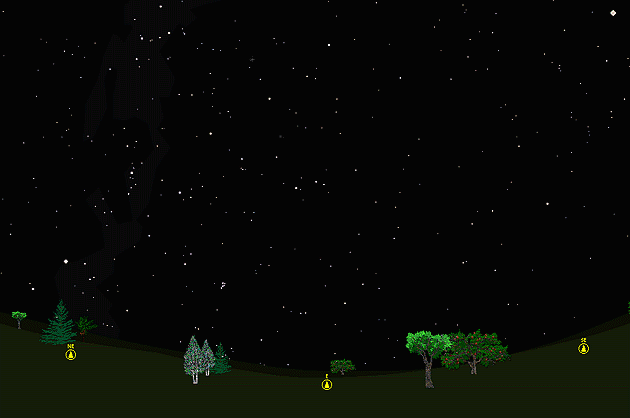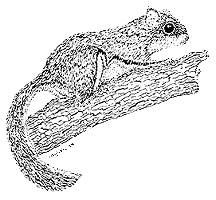The purpose of this feature is to give scout
leaders, educators and naturalists an idea of some of the natural events coming
up each month. We will try to cover a variety of natural events ranging
from sky events to calling periods of amphibians, bird and mammal watching
tips, prominent wildflowers and anything else that comes to mind. We
will also note prominent constellations appearing over the eastern horizon at
mid-evening each month for our area for those who would like to learn the
constellations. If you have suggestions for other types of natural
information you would like to see added to this calendar, let us know! Note: You can click on the hyperlinks to learn more about some of the featured items. To return to the Calendar, hit the "back" button on your browser, NOT the "back" button on the web page. Sky Events: Evening Sky: Mars is still bright now, but is diminishing in size as earth leaves it behind. Uranus remains close to Mars in October, and you can use Mars to guide you to the distant gas giant. On the 15th, use binoculars to look above Mars for a pattern of stars that seems to form a reverse "7" , with Mars at the base of the "7" (marked with red tick marks above Mars in the figure below) and Uranus at the top of the "7". The green circle shows the field of view of a typical pair of binoculars. Telescopic views require about 150 power to see the tiny pale greenish disk of the planet. After the 15th, Mars will be drifting to the west (left in the figure) of the stars that form the "7".
If you happen to be in a location that has a dark sky at midmonth, you may want to see if you can spot the Helix Nebula with binoculars. At a distance of around 650 light years, the Helix Nebula is one of the nearest examples of a "planetary nebula". The clouds of gas that we see have been cast off from the central star of the nebula. Although the Helix appears large (1/2 the size of the full moon) its surface brightness is very low. To see this "Halloween ghost" the moon must not be above the horizon. The Helix is truly a challenge for binoculars, and you need a night where you can easily see the Milky Way overhead to have a chance of seeing it. The farther away from city lights, the better. Look below Mars on the 15th for the pattern of stars marked with red tick marks on figure above. No color will be visible - you will only be able to see the nebula as a very faint grayish patch of light. Use averted vision - look slightly to one side of the position where you think the nebula will be. This technique allows the light from the nebula to fall on the more light sensitive "rods" of your retina. If you begin sensing its presence in this way, and then look directly at it, it will usually disappear. Pretty spooky, huh? I have seen this nebula from our farm using Zeiss 8x30 binoculars on a number of occasions, so you don't need a large pair of binoculars, just a very clear, moonless night. Saturn rises about 11:00pm at midmonth in central Gemini. Venus is in the evening sky now, but still sets soon after the sun. You might try scanning above the western horizon with binoculars about 20 to 30 minutes after sunset. Do not try before sunset - your eyes can be easily damaged if you accidentally point your binoculars at the sun.
Morning Sky: Jupiter rises about 3:30 am at midmonth. Towards the beginning of the month you may be able to spot Mercury below Jupiter in the predawn sky. Shown is the view looking east at 6:15am on October 6th.
The Orionid meteor shower occurs on the morning of October 22nd. The best time to observe this shower is from midnight to about 4:00am, when the crescent moon will rise. Look southeast towards Orion. Although the expected number of meteors per hour is only around a dozen, this shower has a reputation for producing bright meteors with persistent trains. This shower occurs when earth runs into the debris trail from comet Halley.
All times noted in the Sky Events are for Franklin, Tennessee and are Central Daylight Time. These times should be pretty close anywhere in the mid-state area. Constellations: The views below show the sky looking east at 9:00pm CDT on October 15th. The first view shows the sky with the constellation outlined and names depicted. Star and planet names are in yellow. Constellation names are in green. The second view shows the same scene without labels. Prominent are Cassiopeia, Queen Cassiopeia, Andromeda, Princess Andromeda, Perseus, Triangulum, the Triangle, Aries, the Ram, and Cetus, the Sea Monster. Look above beta Andromedae and see if you can pick out the faint glow of the M31, The Andromeda Galaxy, over 2 million light years away! City dwellers may need binoculars to pick it out. Simon Marius, in 1610, compared its soft glow to "the light of a candle shining through horn." To get the best view, wait until the square is high overhead to look. If you find the Andromeda Galaxy, you might want to try to see M33, another nearby galaxy in Triangulum. Auriga, the Charioteer, with its bright star Capella, and Taurus, the Bull, are rising in the northeast. Look for the Pleiades, a beautiful open star cluster, not far above the eastern horizon. Also known as the "Seven Sisters," this cluster has been known since antiquity.
On Learning the Constellations: We advise learning a few constellations each month, and then following them through the seasons. Once you associate a particular constellation coming over the eastern horizon at a certain time of year, you may start thinking about it like an old friend, looking forward to its arrival each season. The stars in the evening scene above, for instance, will always be in the same place relative to the horizon at the same time and date each October. Of course, the planets do move slowly through the constellations, but with practice you will learn to identify them from their appearance. In particular, learn the brightest stars for they will guide you to the fainter stars. Once you can locate the more prominent constellations, you can "branch out" to other constellations around them. It may take you a little while to get a sense of scale, to translate what you see on the computer screen or what you see on the page of a book to what you see in the sky. Look for patterns, like the stars that make up Cassiopeia. The earth's rotation causes the constellations to
appear to move across the sky just as the sun and the moon appear to do.
If you go outside earlier than the time shown on the charts, the constellations
will be lower to the eastern horizon. If you observe later, they will
have climbed higher. As each season progresses, the earth's motion around the sun causes the constellations to appear a little farther towards the west each night for any given time of night. The westward motion of the constellations is equivalent to two hours per month. A good book to learn the constellations is H. A. Rey's
classic, The Stars, A New Way to See Them. Rey's depictions of the
constellations and witty commentary are terrific. A good general reference book on astronomy is the Peterson
Field Guide, A Field Guide to the Stars and Planets, by Pasachoff.
The book retails for around $14.00. A good beginners software program for learning the night sky
is the Starry Night Beginner program. Visit the Starry Night web site at
www.starrynight.com The program retails for around $30.00 and
contains a wealth of information. Amphibians:
The frog and toad choruses continue to diminish in October, but some frogs and toads are still calling. Another name for the Spring Peeper is the "Autumn Piper", and these small frogs can be heard calling from patches of woods in the fall. On cool October nights, Southern Leopard Frogs sometimes call and breed as the cooler temperatures mirror their early spring breeding period. Upland Chorus Frogs sometimes give a very dry, raspy version of their call in October. You can locate many of the frogs and toads that have been calling more frequently earlier in the year by driving the back roads slowly on rainy nights. This is a two person job. One person watches the road for amphibians and one person looks out for other vehicles. Anything over about 15mph is "speeding".
Birds: Fall migration continues. Try to get out and bird as often as you can. Recommended: Bird Finding in Tennessee, Michael Lee Bierly. A classic guide to finding birds in Tennessee. The Sibley Guide to Birds, David Allen Sibley The Sibley Guide to Birds of Eastern North America, David Allen Sibley This new Sibley Guide covers only eastern North America, is quite compact, and is less expensive than the larger Sibley. An inexpensive guide for beginners is the Golden Guide for Birds.
Flying Squirrels:
This time of year flying squirrels at our farm become quite active in nut-bearing hickories at night. Listen for their high-pitched metallic notes. To me the sound is similar to the sound that steel rails make (the "singing" ) as a train approaches. If you have blue bird boxes on your property, you might check them to see if a flying squirrel resides there during the daylight hours.
Archives (Remember to use the back button on your browser, NOT the
back button on the web page!)
Natural Calendar
September 2003
Natural Calendar
February 2003
Natural Calendar
December 2002
Natural Calendar
November 2002
Nature Notes Archives:
Nature Notes was a page we published in 2001 and 2002 containing our
observations about everything from the northern lights display of November 2001
to frog and salamander egg masses. Night scenes prepared with Starry Night Pro software All photographs except Helix Nebula Ó2003 LEAPS *Helix Nebula Credits: NASA, NOAO, ESA, the Hubble Helix Nebula Team, M. Meixner (STScI), and T.A. Rector (NRAO).
|






